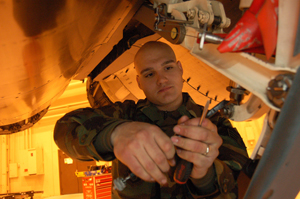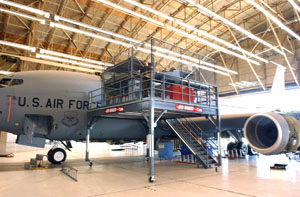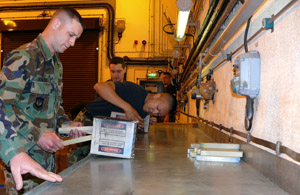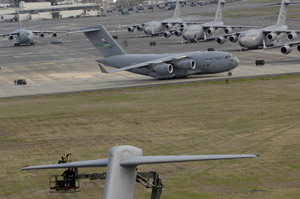AFSO21—the efficiency drive once widely regarded as a grab bag of lofty goals and fuzzy concepts—has turned into something very different. For airmen and civilians alike, it has become a way of life.
The subject is “Air Force Smart Operations for the 21st Century.” At times, an AFSO21 project comes down from on high—say, a general orders a massive overhaul of some process that could have significant positive effects across the force. Others have more humble provenance. Officials note, however, that small changes total up to something big, and that is why airmen at all levels are encouraged to look for efficiencies everywhere.
 |
SrA. Scott Rodrigues removes a tail hook dampener from an F-15E at Elmendorf AFB, Alaska. The inspection was streamlined by seven days as a part of AFSO21. ( |
For example, one officer at Davis-Monthan AFB, Ariz., noticed the existence of old abandoned railroad tracks around the base. Sensing potential paydirt, 1st Lt. Cynthia Darnell combed the desert, taking detailed inventory of the tracks. The result: a sale of scrap metal that fetched $100,000—money the Air Force will plow back into the base itself. Cleaning up the unused tracks is also considered an environmental success story.
It was precisely the hope for such simple, common-sense ideas that induced then-Secretary of the Air Force Michael W. Wynne to launch AFSO21 in early 2006. Greater efficiency was needed, he observed, if the Air Force was to make the most of its budget and shrinking manpower pool.
One need only walk into the project’s modest offices in Arlington, Va., to see that AFSO21 could not succeed without the enthusiastic buy-in by many of USAF’s 700,000 military and civilian personnel. On a good day, the AFSO office has only about 20 workers on hand, far too few to carry the project load on their own.
“You don’t think we’re going to force this Air Force to do something it doesn’t want to do, do you?” asked Ronald C. Ritter, special assistant to the Secretary of the Air Force for AFSO21. “Our job is to understand what the goals—the real objectives—are, and help these people do what is already basically in their heads.”
It is true that, despite Wynne’s efforts to make AFSO21 a service priority, there has been pushback from some airmen. After all, terms such as “lean six sigma” (a widely used business management strategy), in isolation, are unlikely to mobilize the rank and file to find ways to streamline their jobs, AFSO21 leaders admit.
Brig. Gen. John D. Posner, AFSO21 director, said the initial resistance paralleled the Air Force’s experience a decade earlier when it moved to create Air Expeditionary Forces. Posner also acknowledged that past efficiency crusades often have not worked, a fact that makes some longtime personnel skittish about uprooting policies and processes for something new.
“My experience is, initially, people kind of resist a little bit—‘We’re doing OK now, why do we need to change?’ ” said Posner, who took over as director of the AFSO21 office earlier this year. “I think that is just human nature.”
Simply put, Air Force personnel want to see results—and judge for themselves the effectiveness of AFSO21. Airmen “don’t get excited about a well-run program,” Ritter said. “We do.” To the airmen in the field, he added, “the fact that we have a perfectly smooth and glitzy AFSO program is a side note.”
The changes have surprised Posner, who initially thought it would take an entire generation for the Air Force to accept and adopt a system for reforming the service’s business processes. AFSO21 has caught on, he now says. There are a thousand stories of skeptical airmen who became big fans.
The challenge, Ritter said, is in broadcasting local success stories to far-flung personnel.
Several examples came from Robins AFB, Ga., and its Warner Robins Air Logistics Center. Center personnel, who already had been streamlining operations for the last decade, quickly embraced Wynne’s March 2006 directive. They have since been able to eliminate unnecessary tasks and improve output, saving millions of dollars.
An illustrative success story concerns the C-5 transport depot maintenance line. Technicians have been working hard to make processes more efficient. In Fiscal Year 2001, the number of C-5s in maintenance at any given time averaged 15. By Fiscal 2006, that number had decreased to seven. This has the direct combat effect of increasing the size of the operational fleet.
 |
SSgt. Chris Moore prepares to inspect an aircraft part. He stands on a cargo door platform work station, which was an AFSO21 idea. |
Broad Application
“Nowhere is this more evident than in the theaters of operation,” said Maj. Paul Ashley, maintenance operations officer for the 559th Aircraft Maintenance Squadron. In Afghanistan and Iraq, he said, increased C-5 availability has freed up other airlifters for different kinds of duties.
Moreover, Robins officials have been able to reduce the C-5 maintenance work force by 90 people, with cost avoidance of about $7.2 million.
Success at Robins has not been limited to its aircraft depot lines. The center has reinvented information technology processes, with particular attention to the center’s help desk capabilities.
Instead of keeping 17 different help desks positioned around the base, officials decided to establish a “zone help desk.” This essentially created a centralized office to monitor the activity of several geographic zones, said Carl Unholtz, deputy chief information officer at Warner Robins. Centralizing the help desk operations allowed IT officials to monitor their entire workload and shift personnel as necessary.
The result was an exponential improvement in the desk’s responsiveness to needs around Robins. The help desk chalked up 2,000 more calls, on average, in March 2008 than it did in March 2007, but the average length of those calls decreased from 18 minutes to just five. And the average time before calls were answered dropped from nearly a minute-and-a-half to 16 seconds.
Unholtz added that the help desk changes, combined with other improvements to IT services, have reduced by 200 the number of IT professionals needed on the base, which has produced a huge savings. “This is well worth the investment,” Unholtz said. “With lean [operations], you get a smarter solution sooner.”
Robins has therefore freed up 290 positions just by improving its C-5 maintenance and IT help desk operations. This has been one of AFSO21’s drivers all along—the need for the Air Force to do more with fewer dollars.
With its sprawling depot lines and 25,000 military and civilian personnel, Robins was a logical place to seek additional efficiencies. The base is now deemed to be on the cutting edge of AFSO21, but success stories—in varying degrees—can be seen at Air Force bases around the world.
As AFSO21 advocates tell it, these successes have sweeping implications for the service.
“When you get 700,000 airmen all working the same agenda, … they’re going to generate enormous amounts of resources [by] freeing them up,” Ritter said.
The AFSO21 campaign has been aided by the constant influx of airmen recruits. The newcomers do not recall a time when the push for constant improvement and efficiency was not a normal part of Air Force life. For the new airmen, AFSO21 is “just the way you do business,” Posner said.
The Air Force has decided to push AFSO21 training into every training level above basic training. Already, various levels of command and occupational specialties have in place formal AFSO21 training structures, ranging from one-week courses to intense, three-month courses.
 |
SrA. Jason Benchich (left) and SrA. Lester Delvalle (center), at RAF Lakenheath, Britain, test an AFSO21 initiative: an assembly-line approach to restocking chaff and flare cannisters. |
Constant Effort
Every general officer, Senior Executive Service civilian, and command chief in the Air Force must go through a brief immersion course that includes a full-day classroom session on AFSO21 basics, management tools, and implementation ideas. The immersion also includes meetings with industry to illustrate similar successes in the private sector.
Posner asserts that “this has to be a continuing, consistent, persistent, ongoing, enduring process” that lasts for the entirety of an airman’s career. Without constant effort, the force would relapse into old ways and innovation could cease.
Posner and Ritter acknowledge that the Air Force must do a better job pushing successful programs throughout the service. They also worry that there isn’t enough information sharing going on between the Air Force and the other services and across the federal government. “We are not very good at cross-flowing best practices, to put it mildly,” said Ritter, who has worked in the private sector and said USAF’s problems are similar to those of large corporations.
Ritter pointed to a project at Vandenberg AFB, Calif., to replace many of the installation’s lightbulbs with more energy efficient lights. Vandenberg has set goals to reduce energy consumption by three percent per year and use renewable energy sources to power at least 25 percent of the base by 2025.
If the light project were adopted across the Air Force, the service could save between $20 million and $30 million a year, Ritter said. Much larger savings would be realized if such changes were adopted throughout all Defense Department military installations or across the government.
“We are taking way too long” to carry out that expansion, said Ritter. “The guys at Vandenberg … want us to be responsive and jump on it.” They argue that slow progress cheats the Air Force of resources. “We’re missing all the opportunities of this thing because it takes forever” for improvements to be agreed upon and implemented, Ritter said. “This cross-flowing is our biggest opportunity to significantly ratchet up the good work that’s being done out there.”
The AFSO21 office has an official dedicated to that issue and to determining how best to speed changes across the service. Expanding local programs across the service will become a central focus for the top-level AFSO21 Process Council, which meets quarterly to review AFSO21 programs, Posner added.
 |
With C-17s in the background at McChord AFB, Wash., airmen replace an integrated flight-control module on another. Maintainers are incorporating AFSO21 recommendations to shorten the time for an engine-running crew change. |
Posner wants to dispel concerns that AFSO21 is merely an offshoot of the service’s belt-tightening efforts, which had included sweeping personnel reductions. “There has been an unfortunate linkage to resource cuts,” he said. “And we cannot emphasize enough that AFSO21 is not about resource cuts. AFSO21 is about improving performance.”
The point of AFSO21, officials say, essentially is to coordinate efforts and focus the Air Force on continual improvement. “We’ve been doing this ever since we had an Air Force,” Ritter said.
In any event, there’s no going back. As Unholtz puts it: “When we’re not completely reinventing and transforming … some aspect of our business, then we’re using lean [processes] to continually improve. I’m not sure we can even remember how to do business any other way.”
Megan Scully is the defense reporter for National Journal’s CongressDaily in Washington, D.C., and a contributor to National Journal and Government Executive. Her most recent article for Air Force Magazine, “Volunteers in a Time of War,” appeared in the December 2007 issue.